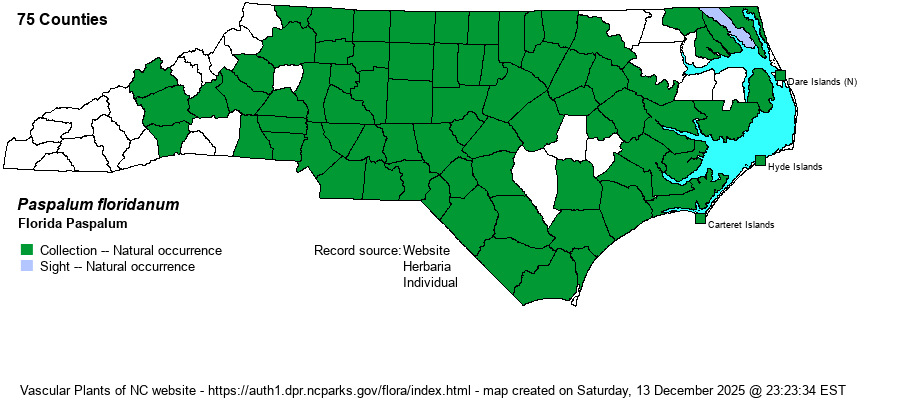| Author | Michaux | |
| Distribution | Across the state, except scarce in the Mountains.
NJ to KS, south to FL and TX. | |
| Abundance | Frequent to common throughout, except rare to uncommon in the Mountains. | |
| Habitat | Most NC records are from open roadsides and woodland openings, the soil dry to moist. Also found in pine-wiregrass woodlands and savannas, and prairie-like areas. | |
| Phenology | Flowering and fruiting August-October. | |
| Identification | This is our tallest (to 5 feet high) and most robust crowngrass. Most populations are glaucescent throughout and glabrous, while others are olive-green, and pilose on leaf sheaths and blades. The two populations occur in most of the same habitats, but do not grow together, as far as is known. | |
| Taxonomic Comments | Pilose plants have been treated as var. floridanum, the glabrous plants as var. glabratum. We lump them here, since they occupy the same range and habitats; Weakley (2018) also does not consider them as distinct.
Paspalum is a genus of more than 300 species, found mostly in the New World. The genus is quite easily identified by the neat row of spikelets along each side of a flattened rachis (inflorescence branch), and also by the hemispherical outline of each spikelet. In some species there are only 2 such inflorescence branches, paired at the stem summit; in most of our species there are 3-4 branches; and in a few there may be many. Keys ask whether spikelets are paired or not -- that is, at each node on each side of the rachis there are pairs of spikelets on tiny stalklets. Care must be taken with a hand lens to make sure there are 2 stalklets at each node, as frequently one of the two spikelets will not grow. Non-paired or single spikelets will clearly have only a single stalklet per node. | |
| Other Common Name(s) | None. Surprisingly, no references seem to use Florida Crowngrass as a common name, even though species in the genus Paspalum are generally known as crowngrasses. | |
| State Rank | S5 | |
| Global Rank | G5 | |
| State Status | | |
| US Status | | |
| USACE-agcp | FACW link |
| USACE-emp | FACW link |

